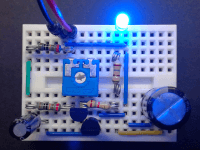SIMPLE FADING LED

Simple but effective all-analog fading LED circuit.
This simple fading LED circuit is basically a relaxation oscillator based on a PUT (Programmable Unijunction Transistor) device, that is formed by two common complementary bipolar transistors (that everyone probably has in the drawer) instead of the original "exotic" component, which is quite difficult to find.
It may be interesting to look at the original ON Semiconductor documentation about this unusual devices.
In the circuit that I'm proposing, the resistor R3 determines the discharging time of the timing capacitor C1 (whereas R1 determines the charging time), obtaining an approximate triangular waveform at TP1 (instead of the usual sawtooth) and consequently an approximate square waveform at TP2. The resistor R4 and the large capacitor C2 form a passive integrator circuit that smoothes the square wave, allowing us to drive the LED, therefore obtaining a properly gradual fade-in and fade-out effect (see waveform at TP3).
The available current is enough to drive a common high brightness LED. Due to the transistor kind, the tolerance of the components and the power supply voltage, R2 must be adjusted in order to obtain the best visual effect possible.
The behavior of the circuit is truly analog. Experimenting different components' values you can also easily change the speed and the fade-in/fade-out timing.
Enjoy!
It may be interesting to look at the original ON Semiconductor documentation about this unusual devices.
In the circuit that I'm proposing, the resistor R3 determines the discharging time of the timing capacitor C1 (whereas R1 determines the charging time), obtaining an approximate triangular waveform at TP1 (instead of the usual sawtooth) and consequently an approximate square waveform at TP2. The resistor R4 and the large capacitor C2 form a passive integrator circuit that smoothes the square wave, allowing us to drive the LED, therefore obtaining a properly gradual fade-in and fade-out effect (see waveform at TP3).
The available current is enough to drive a common high brightness LED. Due to the transistor kind, the tolerance of the components and the power supply voltage, R2 must be adjusted in order to obtain the best visual effect possible.
The behavior of the circuit is truly analog. Experimenting different components' values you can also easily change the speed and the fade-in/fade-out timing.
Enjoy!



Diskussion (3 Kommentare)